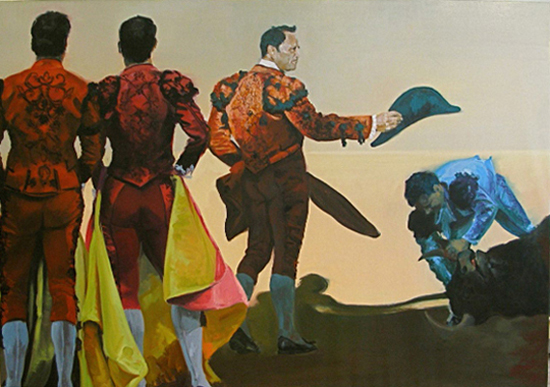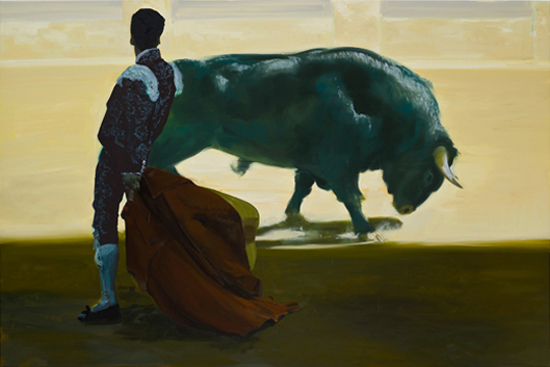Jennifer Park

Corrida in Ronda #6, 2008, oil/linen. 84″ by 108″, image courtesy of the artist.
I contacted Eric Fischl in November 2009 for an interview. His latest series of paintings, titled Corrida in Ronda, had debuted in Berlin at Jablonka Galerie earlier that year, followed by a run at Mary Boone Gallery in NYC. The series was recently on view at the Centro de Arte Contemporáneo Malága in Malága, Spain.
Eric Fischl’s influence was heavy in the 1980’s — the collective desire for representation via new media was strong, and it looked as though painting would become an obsolete commodity. Fischl jolted painting with psychosexual tableaux borne from the domiciles of suburban America. Since then he has transported his audience to India, Italy, and the Museum Haus Esters in Germany; in 2007, Fischl traveled to Spain to consider the narratives within the classical yet controversial Spanish tradition of the Corrida goyesca de Ronda, or bullfight, famously held every year in the Andalusian province of Ronda. The palpable sexuality so prevalent in his oeuvre has been decompressed in these paintings, nuanced and contained within metaphor and history. The voyeuristic element that is the essence of Fischl’s work is still present, as the viewer takes on the role of the audience member.
The corrida was fertile ground for a pantheon of artists in art history; Fischl personally attended a corrida during his Spanish holiday. It was this marriage of old and new – reverting to historical themes while exploiting the technology of photography, Fischl took his own photos for source material, which proved to be provocative. The paintings summarize the spectacle in the form of large-scale stretched linen canvases. Each is a picturesque tableau-vivant replete with brilliant colors of Mediterranean earth and light and rich jewel tones of costume and flair. There is also an emphasis on gesture and posture – these are all welcome distractions from the sport’s emotional implications. Light and shadow create atmosphere and heighten the drama.
“Rewind” implies retrospection, reminiscing, memory recall, history. The Corrida in Ronda paintings remind us to recognize that both culture and painting have persisted, and are still very much alive. The corrida has sustained itself despite the fact that it is viewed as antiquated and inhumane and much like painting has survived in the Modernist era.

Corrida in Ronda #3, 2008, oil/linen. 72″ by 108″, image courtesy of the artist
Jennifer Park: Were your earlier paintings testament of your own childhood? Or were they borne out of a general fascination for the dark side of suburban America and its sexually depraved humanity? Was there a defining moment or event in your life, traumatic or otherwise, that altered your subjective reality, and if so, did you expect this event to be so pivotal to the central theme of your work?
Eric Fischl: You paint what you know, not what you understand. There is a difference.
JP: Within the painting process, there seems to be a metaphysical discourse that occurs between the painting and its tactile and physical qualities – form, color, surface texture, value and light – and the subject matter. There is always the possibility that a conflict will ensue between the painting and subject matter, and what is seen or felt is not exactly reconciled with the qualities inherent to the painting. Or conversely, the subject matter informs the painting, and vice versa. Do you find that this happens often with your own studio practice?
EF: Painting welcomes paradox. And painting, having allowed it in, contains it. Art becomes meaningful when contradictions are held in an exquisite equilibrium.
JP: Your latest series of paintings, Corrida in Ronda is based on the Spanish tradition of the bullfight, or Corrida Goyesca, in the southern Spanish town of Ronda. Please allow me to be somewhat political, here. The pathos of these paintings is undeniable – do you believe that bullfighting is an inhumane blood sport that has become antiquated? Or do you think that this mode of thought is cultural imperialism?
EF: No. There is nothing inhumane about it. It is respectful of the bull and the position it has been put into. What is truly inhumane is the way we treat chickens and pigs and cows for our meat industry. That is a crime. What is complicated about the bullfight is the line it walks between art and life, between sport and life. It is the only performance/ritual that ends in a death. That breaks the illusion of art. That breaks the metaphor.
JP: Though there is a reoccurring theme of sexuality in your oeuvre, some have suggested that you have put this to a halt with the Corrida In Ronda paintings. I find these paintings to be aptly sexual, however, as the bull is regarded as an iconic animal in some cultures; an allegory for male sexuality and virility. I feel that the erotic context comes from this subtle metaphor. Is there a connection between the machismo qualities of this sport, and the sexuality of the toreadors depicted?
EF: What struck me about the bullfight is that it is a ritual of transition, beautifully constructed, poignantly symbolic, from boy to man. The bull first enters the ring alone and races around crazed, unpredictable, powerful. He is the symbol of male potency. Shortly the torero and bandiero’s appear in the arena. They carry capes. There is nothing hard or dangerous in these capes. They taunt the bull with them. They test each other’s bravery. They are like school children playing at being brave. Then the picador comes out atop his horse. The horse is the symbol of change, the symbol of transition (think Pegasus who moves between earth and the heavens). As soon as the bull sees the horse he attacks it and the picador inflict [sic] the first wound. The game has turned suddenly real. Now the bandiero’s hold spears in their hands and further taunt and further wound the bull. The spears are brightly colored. They look like fireworks exploding from the wounds in the neck. The ritual heats up. Now the torero reappears and this time he holds a cape with something hard and something lethal in it. He enters into the most intimate dance with the bull. Both bull and torero risk their life in this pas de deux. It is inevitable that the bull will die. What is not certain is whether the torero will make the transition unscathed. What is demanded of him is grace, eloquence and accuracy within the final moments.
We do not have anything even approaching this ritual of transition from adolesence [sic] to manhood. Certainly not something that is woven so intricately into the fabric of the society. Yet this moment in a boy’s life is a profound one. It is a complex and complicated one that is experienced by all males and shared by the whole society. However, in our country this moment is not celebrated. It is denied or ignored or met with irritation as if it was an inconvenience that will pass.
JP: In keeping with the topic of sexuality, I once read a provocative statement that you made in an interview with Isabelle Bonzom, and it stayed with me ever since – you admitted to using sex as a currency of exchange that sets up a particular dynamic between people. This time around, sex still seems to be the preferred mode of exchange, but in a different sense; and, in this case, the dynamic is between human and animal. Could it be that the toreadors that are depicted are attempting to channel some intrinsic quality of the bull to their own egos by slaying the beast, as the sexual potency of the felled bull is one that is to be relinquished to the toreador? Or is this meta-narrative or narrative schema rather meaningless?
EF: This question is answered above. I will add for clarity that my comment about sex being a currency of exchange is that it is a way to measure the space and the emotions that are in play between the people involved. It is a way to measure need and desire, expectation and disappointment.
JP: There is a distantly familiar aspect of these paintings. Atmospherically and compositionally, these paintings are reminiscent of Goya’s etchings, in their harrowing and existential quality. What artists might have informed your color palette?
EF: There is a long and great tradition for painting the bullfight. Goya is one of the giants within this tradition. Other obvious examples would be Manet (who probably never went to a bullfight but looked at Goya’s paintings) and Picasso.
Goya’s paintings depicting the bullfight are full of pathos. They identify mostly with the men at the moment when things have gone off track a bit. The horse has been gored. The torero has been gored. There is a lot of chaos and agitation in the compositions. The crowds are unorganized.
I share the sentiment with Goya that the “arena” of the bullfight is existential. My focus for the most part was on those last few moments as life drains out. It is from the bull’s perspective and for me it was a meditation on one’s inability to understand the context and purpose of a life that led him to this moment.
The color is from the bullfight. These are the colors of the torero’s, bandiero’s and matador’s costumes. This is the color of the light and the color of the earth in southern Spain.
Painting can never be outside the tradition of painting. The work that has been done before informs the work one does now. You will find similar palettes in Michaelangelo’s Sistine Chapel, Tiepolo, Monet, de Kooning, and Hockney.
JP: If you feel that the arena of the bullfight is existential, would that explain why you have chosen not to depict the audience?
EF: Yes. Were I to put in the audience then we (the viewer) would be watching the audience watch/witness the drama. I want my audience to be more directly connected to that which is taking place in front of them.
JP: In an earlier interview with Ilka Scobie, you spoke of the art world of the 80’s versus the art market that exists in the present. You stated that you wanted to go back to the art world of the 80’s; imagine that it is still 1983, for example – the year in which I was born. This was also the year of Birthday Boy and others. In terms of critical reception, how would the art world of 1983 receive the Corrida In Ronda paintings? Do you think that the 1980’s art world would be a more auspicious platform for your works as opposed to the present state of things? (This is not to say that your current works are not successful in and of themselves).
EF: The short answer is the Corrida paintings would not have been the paintings that put me on the radar screen the way that Bad Boy, Sleepwalker and Birthday Boy did. I am quite certain that they would have been ignored. But having said that, you must understand that there is a moment when something comes together, something gels; it is a Zeitgeist and if you hit it right you will be the one that represents that moment. Timing, timing, timing is everything. The Corrida paintings would not have opened the door or broken down the walls but I could not have done the Corrida paintings back then. I was too young. The Corrida paintings are where I am at now and all the work I have done to date is the path that led me to them.
Jennifer Park is an artist in Atlanta, Georgia.